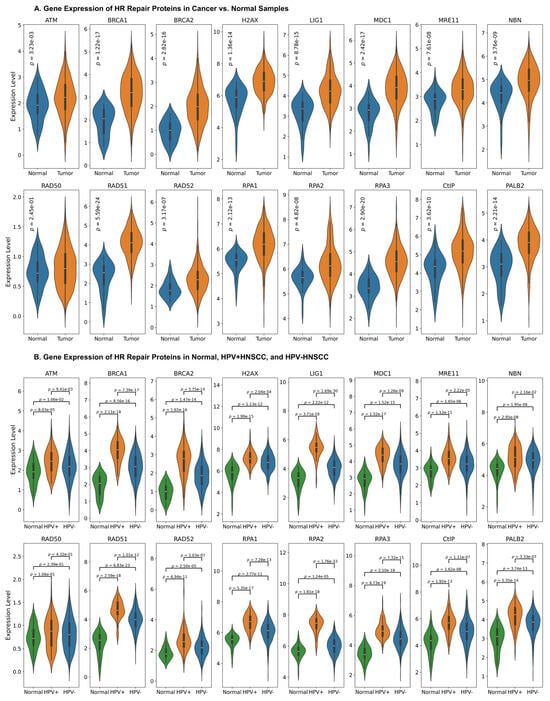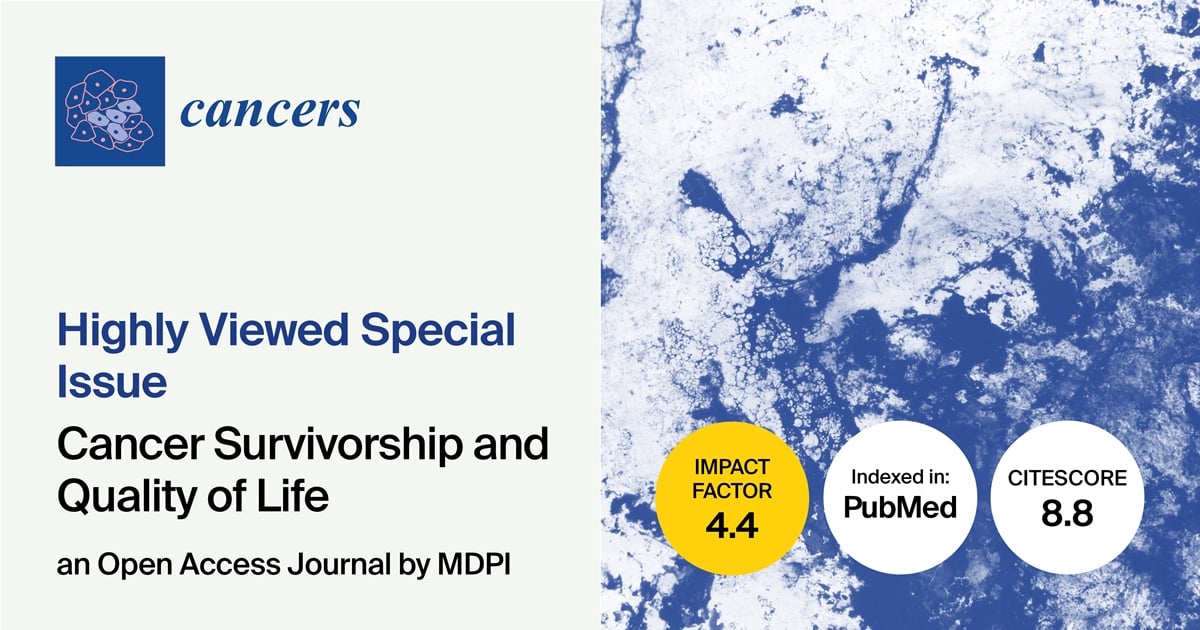-
 The Tumor Environment in Peritoneal Carcinomatosis and Malignant Pleural Effusions: Implications for Therapy
The Tumor Environment in Peritoneal Carcinomatosis and Malignant Pleural Effusions: Implications for Therapy -
 Integrating Molecular Phenotyping into Treatment Algorithms for Advanced Oestrogen Receptor-Positive Breast Cancer
Integrating Molecular Phenotyping into Treatment Algorithms for Advanced Oestrogen Receptor-Positive Breast Cancer -
 Dermal Mitoses Correlate with Surgical Burden in Lentigo Maligna Melanoma: PRAME for Margin Assessment
Dermal Mitoses Correlate with Surgical Burden in Lentigo Maligna Melanoma: PRAME for Margin Assessment
Journal Description
Cancers
Cancers
is a peer-reviewed, open access journal of oncology, published semimonthly online by MDPI. The Irish Association for Cancer Research (IACR), Spanish Association for Cancer Research (ASEICA), Biomedical Research Centre (CIBM), British Neuro-Oncology Society (BNOS) and Spanish Group for Cancer Immuno-Biotherapy (GÉTICA) are affiliated with Cancers and their members receive a discount on the article processing charges.
- Open Access— free for readers, with article processing charges (APC) paid by authors or their institutions.
- High Visibility: indexed within Scopus, SCIE (Web of Science), PubMed, PMC, Embase, CAPlus / SciFinder, and other databases.
- Journal Rank: JCR - Q2 (Oncology) / CiteScore - Q1 (Oncology)
- Rapid Publication: manuscripts are peer-reviewed and a first decision is provided to authors approximately 20.3 days after submission; acceptance to publication is undertaken in 2.6 days (median values for papers published in this journal in the first half of 2025).
- Recognition of Reviewers: reviewers who provide timely, thorough peer-review reports receive vouchers entitling them to a discount on the APC of their next publication in any MDPI journal, in appreciation of the work done.
- Sections: published in 18 topical sections.
- Companion journals for Cancers include: Radiation and Onco.
- Journal Clusters of Oncology: Cancers, Current Oncology, Onco and Targets.
Impact Factor:
4.4 (2024);
5-Year Impact Factor:
4.8 (2024)
Latest Articles
Homologous Recombination Is Associated with Enhanced Anti-Tumor Innate Immunity and Favorable Prognosis in Head and Neck Cancer
Cancers 2025, 17(24), 3999; https://doi.org/10.3390/cancers17243999 - 15 Dec 2025
Abstract
Background/Objectives: Head and neck squamous cell carcinoma (HNSCC) is an aggressive malignancy, often diagnosed at advanced stages with poor survival outcomes. Homologous recombination (HR), a major DNA double-strand break (DSB) repair pathway, safeguards genomic stability via error-free repair. While HR deficiency has been
[...] Read more.
Background/Objectives: Head and neck squamous cell carcinoma (HNSCC) is an aggressive malignancy, often diagnosed at advanced stages with poor survival outcomes. Homologous recombination (HR), a major DNA double-strand break (DSB) repair pathway, safeguards genomic stability via error-free repair. While HR deficiency has been well established as a driver of genomic instability and tumorigenesis in several cancer types, the role of HR in HNSCC remains relatively understudied. Methods: Here, we analyzed the expression patterns of key HR proteins in HNSCC and investigated their association with clinical parameters, DNA methylation, immune cell infiltration, and patient survival outcome. Results: Surprisingly, our results demonstrate that HR factors are consistently upregulated in HNSCC, in both HPV-positive and HPV-negative groups. Survival analysis identified many HR factors, including ATM, BRCA1, BRCA2, PALB2, LIG1, RPA1, and RPA2, as potential prognostic biomarkers for better overall survival. Interestingly, we observed a significant correlation between HR protein overexpression and immune cell infiltration in HNSCC, suggesting a potential immunomodulatory role of HR proteins. To experimentally validate this association in both HPV-positive and -negative cell lines, we showed that MRE11 and RAD51 overexpression in HNSCC cells led to increased phosphorylation of IRF3 and STAT1, indicating activation of the cGAS/STING-mediated innate immune signaling. Conclusion: Together, our findings provide a comprehensive overview of the HR pathway in HNSCC, highlighting the dual role of HR proteins in both genomic maintenance and immune regulation. The consistent upregulation of HR proteins, their association with disease progression, and potential immunogenic effects underscore their promise as diagnostic/prognostic biomarkers and therapeutic targets in HNSCC.
Full article
(This article belongs to the Special Issue New Biomarkers in Cancers 2nd Edition)
►
Show Figures
Open AccessArticle
Prediction of Lymphovascular Invasion in Early–Stage Lung Adenocarcinoma Using Artificial Intelligence–Based Radiomics
by
Yoshihisa Shimada, Kazuharu Harada, Yujin Kudo, Jinho Park, Jun Matsubayashi, Masataka Taguri and Norihiko Ikeda
Cancers 2025, 17(24), 3998; https://doi.org/10.3390/cancers17243998 - 15 Dec 2025
Abstract
Objectives: This study utilized artificial intelligence (AI)–based radiomics analysis of computed tomography (CT) images using a modified U–Net for lung nodule segmentation and convolutional neural network based on VGG–16 to predict lymphovascular invasion (LVI) in stage 0–I lung adenocarcinoma. Additionally, the study investigated
[...] Read more.
Objectives: This study utilized artificial intelligence (AI)–based radiomics analysis of computed tomography (CT) images using a modified U–Net for lung nodule segmentation and convolutional neural network based on VGG–16 to predict lymphovascular invasion (LVI) in stage 0–I lung adenocarcinoma. Additionally, the study investigated whether combining radiomics data with serum microRNA (miR)–30d level as a potential biomarker could enhance predictive performance. Methods: A total of 1265 patients who underwent complete resection between 2008 and 2018 were included. AI–based CT analysis was performed, and logistic regression was applied to predict LVI using 35 imaging features. A risk score (RS) generated from 840 patients in the derivation cohort was used to identify a high–risk group, with validation performed using 425 patients. Additionally, 47 cases with extracellular vesicle (EV)–derived miR–30d level data were analyzed to evaluate the value of the integrated approach. Results: Among all the patients, 467 patients (36.9%) were LVI–positive, and LVI was independently associated with poorer overall survival. The receiver operating characteristic curve for LVI based on the RS yielded an area under the curve of 0.899. For LVI prediction, the sensitivity, specificity, and accuracy were 84.8%, 83.7%, and 83.9%, respectively, in the derivation group, and 82.3%, 79.4%, and 80.5%, respectively, in the validation group. The integrated approach with miR–30d enhanced the predictability of LVI, achieving a sensitivity of 93.3%, specificity of 70.5%, and accuracy of 85.1%. Conclusions: AI–based radiomics demonstrated high effectiveness for predicting LVI, with RSs showing broad clinical applications. The addition of EV–derived miR–30d modestly improved predictability.
Full article
(This article belongs to the Special Issue Artificial Intelligence and MRI Characterization of Tumors: 2nd Edition)
Open AccessReview
The Dual Effects of CDK4/6 Inhibitors on Tumor Immunity
by
Yiran Si, Hongli Li and Yehui Shi
Cancers 2025, 17(24), 3997; https://doi.org/10.3390/cancers17243997 - 15 Dec 2025
Abstract
CDK4/6 inhibitors exert effective anti-tumor effects by blocking the cell cycle and, as a result, have become vital in the systemic treatment of malignant tumors. Previous research has indicated that CDK4/6 inhibitors not only exert effects on the cell cycle but also have
[...] Read more.
CDK4/6 inhibitors exert effective anti-tumor effects by blocking the cell cycle and, as a result, have become vital in the systemic treatment of malignant tumors. Previous research has indicated that CDK4/6 inhibitors not only exert effects on the cell cycle but also have regulatory roles in tumor immunity, although the research findings are controversial. This study comprehensively summarizes the molecular mechanisms by which CDK4/6 inhibitors activate or suppress anti-tumor immunity and reveals the dual effects of CDK4/6 inhibitors on influencing interferon signaling, mediating senescence, and altering certain immune cells. In addition, the results of clinical trials of CDK4/6 inhibitors combined with immunotherapy are thought-provoking, with the severe adverse events that occur after treatment being the main factor affecting their therapeutic effect. Therefore, the future direction of this combined treatment strategy deserves further exploration.
Full article
(This article belongs to the Section Cancer Immunology and Immunotherapy)
►▼
Show Figures

Figure 1
Open AccessArticle
The Impact of Demographic and Clinico-Pathological Characteristics on Recurrence-Free Survival in Nasopharyngeal Carcinoma
by
Muhammad Awawda, Majd Hanna, Ahmad Awawdi, Saeed Salman, Natali Shirron and Salem Billan
Cancers 2025, 17(24), 3996; https://doi.org/10.3390/cancers17243996 - 15 Dec 2025
Abstract
Background: Nasopharyngeal carcinoma (NPC) is an uncommon malignancy with a distinct geographical distribution. However, data from non-endemic areas are limited. This study aims to evaluate oncological outcomes and identify prognostic factors in a large cohort of non-metastatic NPC patients treated at a tertiary
[...] Read more.
Background: Nasopharyngeal carcinoma (NPC) is an uncommon malignancy with a distinct geographical distribution. However, data from non-endemic areas are limited. This study aims to evaluate oncological outcomes and identify prognostic factors in a large cohort of non-metastatic NPC patients treated at a tertiary center in Israel. Methods: This single-institution, retrospective study included 181 patients diagnosed with non-metastatic NPC and treated with radiotherapy between 2005 and 2022. Data were collected from electronic medical records and included demographics, disease characteristics, treatment details, and outcomes. Recurrence-free survival (RFS) and overall survival (OS) were estimated using Kaplan–Meier analysis. Cox proportional hazards models were used to assess prognostic factors. Results: The median follow-up was 57 months. The cohort was predominantly male (82%), with a mean age of 51.7 years. Most patients had non-keratinizing histology, 75%presented with stage III–IV disease, and 86% received concurrent chemoradiotherapy. Induction chemotherapy was administered to 71%, though only 6.5% received the full three-cycle regimen. Nearly 90% were treated using modern radiotherapy techniques (VMAT), and 75% received concurrent chemotherapy. The 3-year RFS and OS were 82.6% and 91.2%, respectively; the 5-year RFS and OS were 77.7% and 84.7%. Age threshold analysis demonstrated that younger age predicted improved RFS (HR range, 3–5; p < 0.05). In the multivariate analysis, patients aged > 50 years had a significantly higher risk of recurrence (HR 6.02, 95% CI 1.30–27.85), while stage IV disease showed a borderline association with poorer RFS (HR 2.81, 95% CI 0.96–8.27), reaching statistical significance in the 30–50 years age group (HR = 7.06, 95% CI 1.14–43.76, p = 0.036). Smoking demonstrated a non-significant trend toward increased recurrence risk (HR 1.61, 95% CI 0.85–3.04). Similar patterns were seen for OS, with age >50 showing elevated but non-significant risk (HR 3.43, 95% CI 0.73–16.06), partly due to limited events. Bedouin ethnicity was associated with higher prevalence and a significantly younger age at diagnosis (39.4 ± 16.0 vs. 52.7 ± 16.9 years, p = 0.004), with a non-significantly better outcome. Conclusions: In this non-endemic cohort, favorable oncologic outcomes were observed. The age at diagnosis is a key prognostic factor. The higher incidence, younger age and better outcomes among the Bedouin ethnicity warrant further investigation calling for improved risk stratification and personalized treatment strategies.
Full article
(This article belongs to the Section Cancer Informatics and Big Data)
►▼
Show Figures
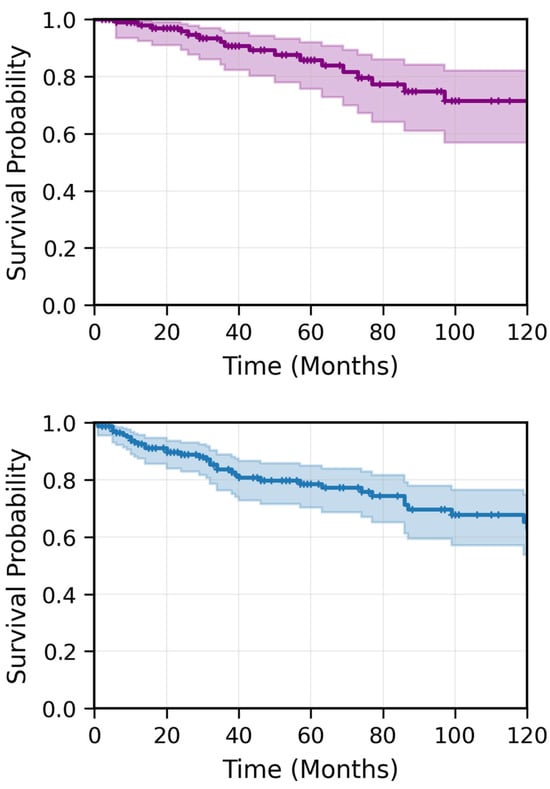
Figure 1
Open AccessSystematic Review
Single Nucleotide Polymorphisms as Biomarkers of Response to Neoadjuvant Chemoradiotherapy in Rectal Cancer: A Systematic Review
by
Katarzyna Połomska, Magda Rybicka, Adrianna Jażdżewska, Magdalena Prud, Stefania Jackowska, Jaroslaw Kobiela and Piotr Spychalski
Cancers 2025, 17(24), 3995; https://doi.org/10.3390/cancers17243995 - 15 Dec 2025
Abstract
Background: Neoadjuvant chemoradiotherapy (nCRT) is the standard treatment for locally advanced rectal cancer, but only 15–30% of patients achieve a pathological complete response. Single nucleotide polymorphisms represent stable genetic markers with potential predictive value for treatment response. This systematic review synthesizes current
[...] Read more.
Background: Neoadjuvant chemoradiotherapy (nCRT) is the standard treatment for locally advanced rectal cancer, but only 15–30% of patients achieve a pathological complete response. Single nucleotide polymorphisms represent stable genetic markers with potential predictive value for treatment response. This systematic review synthesizes current evidence on the association between SNPs and the response to nCRT in rectal cancer. Methods: PubMed and Web of Science databases were searched for relevant English studies. Two reviewers independently screened the titles and abstracts using the DistillerSR tool. Full-text articles were assessed for their eligibility. Data extraction followed the PRISMA guidelines, and the risk of bias was assessed. Results: Thirty-two studies (4116 patients) assessed 304 SNPs across 126 genes in 407 analyses. DNA repair genes (XRCC1, XRCC3, ERCC1, ERCC2) and folate metabolism genes (MTHFR, TYMS) were most frequently investigated. Only two SNPs demonstrated predictive value in multiple studies: rs25487 (XRCC1) and rs1801133 (MTHFR); however, the associations were inconsistent. The remaining SNPs showed isolated associations in single studies. No SNP demonstrated predictive value across independent cohorts. Conclusions: Current evidence does not support the clinical use of individual SNPs to predict nCRT response in rectal cancer patients. Although XRCC1 and MTHFR polymorphisms have been extensively studied, their predictive utility remains inconclusive. Future research should prioritize large, multicenter prospective studies with standardized treatment and outcome definitions, and consider polygenic risk models or integrated multi-omic approaches.
Full article
(This article belongs to the Section Cancer Biomarkers)
►▼
Show Figures
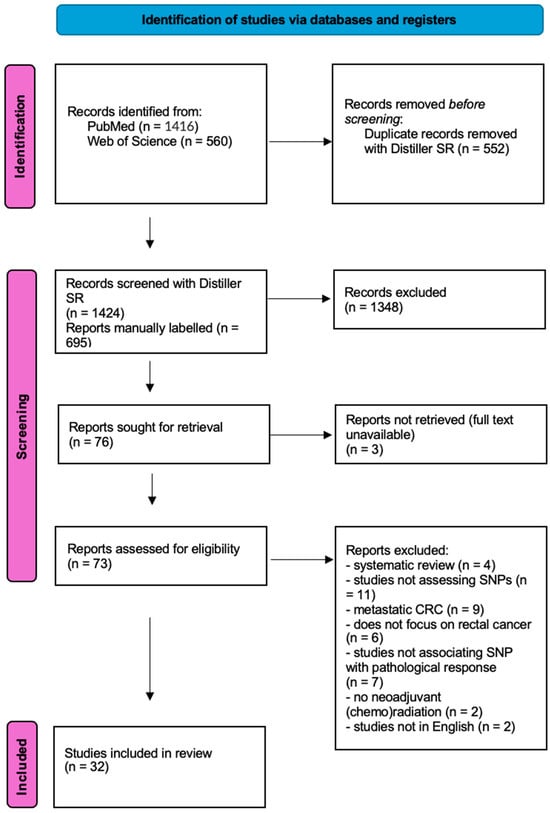
Figure 1
Open AccessArticle
Early BCR::ABL1 Reduction as a Predictor of Deep Molecular Response in Pediatric Chronic-Phase Chronic Myeloid Leukemia
by
Xingchen Wang, Wenbin An, Chenmeng Liu, Bang Zhang, Yunlong Chen, Yang Wan, Xiaolan Li, Lipeng Liu, Fang Liu, Li Zhang, Yao Zou, Xiaojuan Chen, Yumei Chen, Ye Guo, Tianyuan Hu, Yingchi Zhang, Xiaofan Zhu and Wenyu Yang
Cancers 2025, 17(24), 3994; https://doi.org/10.3390/cancers17243994 - 15 Dec 2025
Abstract
Background: Tyrosine kinase inhibitors (TKIs) have transformed the prognosis of chronic myeloid leukemia (CML), but pediatric patients face unique challenges due to prolonged exposure. Early molecular response (EMR, BCR::ABL1 ≤ 10% at 3 months) is a recognized predictor of favorable outcomes in
[...] Read more.
Background: Tyrosine kinase inhibitors (TKIs) have transformed the prognosis of chronic myeloid leukemia (CML), but pediatric patients face unique challenges due to prolonged exposure. Early molecular response (EMR, BCR::ABL1 ≤ 10% at 3 months) is a recognized predictor of favorable outcomes in adults and has been correlated with improved responses in children. However, its relationship with achieving deep molecular remission (DMR, BCR::ABL1 ≤ 0.01%) in pediatric CML remains unclear. Methods: We performed a single-center, retrospective analysis of 103 pediatric patients with chronic-phase CML treated with frontline TKIs. Among them, 88 were evaluable for molecular response. BCR::ABL1 transcript levels were quantified by real-time quantitative PCR on the International Scale, and molecular responses were assessed. Associations between early molecular dynamics and long-term outcomes were evaluated using Kaplan–Meier and cumulative incidence analyses. Results: At 3 months, 64.8% achieved EMR. Early responders had significantly higher MMR rates at 12 months (80.8% vs. 5.6%; p = 0.00018) and DMR at 24 months (70.4% vs. 42.2%; p = 0.029). The ≥0.45-log reduction in BCR::ABL1 transcripts at 3 months predicted shorter times to MMR (median 11 vs. 29 months) and DMR (18 vs. 50 months), as well as higher overall MMR (p = 0.011) and DMR (p = 0.014) incidences. Bone marrow fibrosis correlated with inferior molecular outcomes (p = 0.017 for MMR). Conclusions: Early BCR::ABL1 decline kinetics independently predict molecular depth in pediatric CML. Quantitative early transcript reduction may guide risk-adapted management and optimize long-term TKI strategies in children.
Full article
(This article belongs to the Special Issue Current Research in Pediatric Hematological Oncology)
►▼
Show Figures
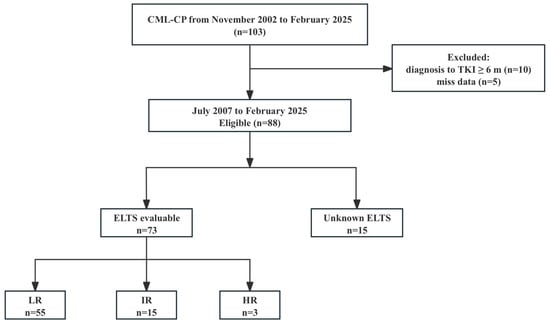
Figure 1
Open AccessArticle
Metabolomic Insights into Prostate Cancer Treatment and Relapse
by
Kristina Lundquist, Henrik Antti and Camilla Thellenberg Karlsson
Cancers 2025, 17(24), 3993; https://doi.org/10.3390/cancers17243993 - 15 Dec 2025
Abstract
Background: High-risk prostate cancer is often treated with combined androgen deprivation therapy (ADT) and radiotherapy (RT). Blood biomarkers may enable treatments to be tailored to individual patients. Metabolomics, the study of small-molecule alterations in blood, is promising, and lipids are emerging as
[...] Read more.
Background: High-risk prostate cancer is often treated with combined androgen deprivation therapy (ADT) and radiotherapy (RT). Blood biomarkers may enable treatments to be tailored to individual patients. Metabolomics, the study of small-molecule alterations in blood, is promising, and lipids are emerging as potential markers of poor prognosis. This study aims to investigate metabolic changes during prostate cancer treatment and their correlation to disease outcome. Methods: This study included 136 blood plasma samples from 35 patients with high-risk prostate cancer treated with RT and ADT, recruited from the Uppsala/Umeå Comprehensive Cancer Consortium (U-CAN) project. Blood samples were collected before, during, and after treatment and analyzed at Metabolon Inc. (Durham, NC, USA). To study differences in metabolic levels during treatment, three different sampling time points were considered: before ADT, in-between ADT and RT, and after RT. Both multivariate (orthogonal projections to latent structures, OPLS) and univariate analyses were performed, where statistical significance in combination with a large fold change was considered indicative of a substantial change. Results: Significant changes in metabolite levels were observed. Many of the significant metabolites for the whole course of treatment were also significant during ADT but not during RT, indicating that changes during ADT dominated the overall treatment. Changes were found to be especially common in steroids and fatty acids. Multivariate analysis revealed significant differences in metabolites between relapsing and non-relapsing patients. Among the significant metabolites were cholesterol and epiandrosterone. Conclusions: Metabolomics can identify biomarkers for prostate cancer treatment response and relapse. Further studies are needed to identify patterns and individual metabolites to personalize treatment strategies for prostate cancer.
Full article
(This article belongs to the Section Methods and Technologies Development)
►▼
Show Figures
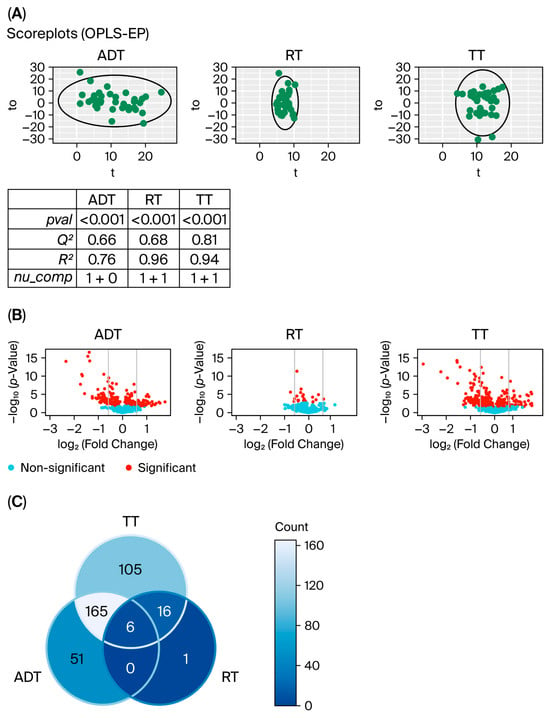
Figure 1
Open AccessArticle
An Exploratory Retrospective Study on the Association of Radiotherapy with the Risk of Immune-Related Adverse Events in Esophageal and Esophagogastric Junction Cancer Patients Receiving Immunotherapy
by
Nobukazu Hokamura, Takeo Fukagawa, Ryoji Fukushima, Takashi Kiyokawa, Masahiro Horikawa, Yuichi Igarashi, Hironori Midorikawa, Shinya Kaneshiro and Kenshiro Shiraishi
Cancers 2025, 17(24), 3992; https://doi.org/10.3390/cancers17243992 - 15 Dec 2025
Abstract
Background: Radiotherapy (RT) combined with immune checkpoint inhibitors (ICIs) has shown therapeutic benefits, and the potential for enhanced immune activation has raised concerns about increased immune-related adverse events (irAEs). The immunological implications of mediastinal RT combined with ICI therapy remain unclear. Methods: We
[...] Read more.
Background: Radiotherapy (RT) combined with immune checkpoint inhibitors (ICIs) has shown therapeutic benefits, and the potential for enhanced immune activation has raised concerns about increased immune-related adverse events (irAEs). The immunological implications of mediastinal RT combined with ICI therapy remain unclear. Methods: We conducted an exploratory retrospective review of 58 patients with esophageal oresophagogastric junction cancer who received ICIs between 2021 and 2024. Patients were categorized into RT (+) and RT (-) groups based on whether they underwent mediastinal RT. The incidence and severity of irAEs were compared using chi-square testing. Subgroup analyses included treatment sequence (RT before vs. after ICI), interval between RT and ICI (<90 vs. ≥90 days), and ICI regimen (nivolumab [N], pembrolizumab [P], or nivolumab plus ipilimumab [NI]). Results: irAEs occurred in 28.6% of RT (+) and 39.1% of RT (-) (p = 0.42). Severe irAEs were uncommon in both groups. Treatment sequence and RT-ICI interval did not significantly influence irAE incidence. irAEs were more frequent in the NI group (85.7%) than in N (22.9%) or P (31.2%) (p = 0.01). Mediastinal RT itself did not increase irAE risk. Conclusions: Although RT combined with ICIs has been hypothesized to elevate irAEs through enhanced immune activation, mediastinal RT did not increase irAEs in this cohort. However, given the exploratory and small patient cohort, these findings suggest, with caution, that mediastinal irradiation may attenuate systemic immune activation through lymphocyte depletion, potentially balancing ICI-induced immune responses.
Full article
(This article belongs to the Section Cancer Immunology and Immunotherapy)
Open AccessArticle
Implementation Rates and Predictors of Compliance with Enhanced Recovery After Surgery Protocols in Gynecologic Oncology: A Prospective Multi-Institutional Cohort Study
by
Vasilios Pergialiotis, Dimitrios Haidopoulos, Alexandros Daponte, Dimitrios Tsolakidis, Stamatios Petousis, Ioannis Kalogiannidis, Dimitrios Efthymios Vlachos, Vasilios Lygizos, Maria Fanaki, George Delinasios, Panagiotis Tzitzis, Philipos Ntailianas, Vasilios Theodoulidis, Georgia Margioula Siarkou, Nikoletta Daponte and Nikolaos Thomakos
Cancers 2025, 17(24), 3991; https://doi.org/10.3390/cancers17243991 - 15 Dec 2025
Abstract
Background: The importance of integrating enhanced recovery after surgery protocols in gynecologic oncology has been proven in numerous studies. However, the actual adherence to protocol among institutions remains inconsistent in clinical practice, particularly among those without prior structured implementation. This pragmatic multicenter study
[...] Read more.
Background: The importance of integrating enhanced recovery after surgery protocols in gynecologic oncology has been proven in numerous studies. However, the actual adherence to protocol among institutions remains inconsistent in clinical practice, particularly among those without prior structured implementation. This pragmatic multicenter study provides a preliminary report from the ongoing ERGO (Enhanced Recovery in Gynecologic Oncology) cohort study (ClinicalTrials.gov: NCT06655506) and aims to evaluate adherence to enhanced recovery protocols during the early phases of its adoption as well as identify factors that determine low uptake. Methods: Overall, 300 consecutive patients undergoing gynecologic oncology surgery across five institutions were included in the present study. Adherence to preoperative, intraoperative, and postoperative enhanced recovery elements was documented using standardized forms. Optimal adherence was predetermined as fulfillment of more than 70% of the enhanced recovery components included in the pathway. Multinomial analysis was used to identify predictors of adherence. Results: Overall, 70.3% of patients achieved optimal adherence; however, rates varied across centers (26.9–84.4%), reflecting the limited institutional familiarity with enhanced recovery pathways in most participating centers. The actual volume of cases handled was an important determinant of adherence, with high-volume units consistently demonstrating substantially higher compliance compared with lower-volume hospitals. Routine preoperative items demonstrated high uptake, whereas several intraoperative and early postoperative components showed low and heterogeneous implementation, which might be the result of anesthesiology-driven practices. Higher surgical complexity and poorer performance status independently predicted reduced adherence. Visual mapping confirmed that complex procedures resulted in lower adherence. Conclusions: The significant variability in enhanced recovery protocol adherence that was observed in our study indicates the need to institute structured workflows that help increase team familiarization, particularly in high-complexity cases and centers new to these elements.
Full article
(This article belongs to the Special Issue Improving the Quality of Life in Patients with Gynecological Cancer)
►▼
Show Figures
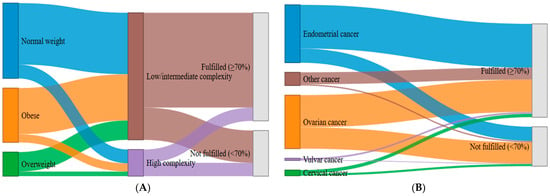
Figure 1
Open AccessArticle
Differential Androgen Receptor Expression Across Bladder Cancer Stages and Its Link to Poor Outcomes
by
Henning Plage, Nadine Biernath, Kira Furlano, Sarah Weinberger, Jonathan Jeutner, Annika Fendler, Florian Roßner, Simon Schallenberg, Sefer Elezkurtaj, Martina Kluth, Maximilian Lennartz, Andreas Holger Marx, Henrik Samtleben, Margit Fisch, Michael Rink, Marcin Slojewski, Krystian Kaczmarek, Stefan Koch, Nico Adamini, Sarah Minner, Ronald Simon, Guido Sauter, Henrik Zecha, Thorsten Ecke, Thorsten Schlomm, David Horst and Bernhard Rallaadd
Show full author list
remove
Hide full author list
Cancers 2025, 17(24), 3990; https://doi.org/10.3390/cancers17243990 - 15 Dec 2025
Abstract
Urinary bladder cancer is the tenth most common malignancy worldwide and represents a major global health burden [...]
Full article
(This article belongs to the Special Issue Biomarkers of Urological Cancers)
►▼
Show Figures
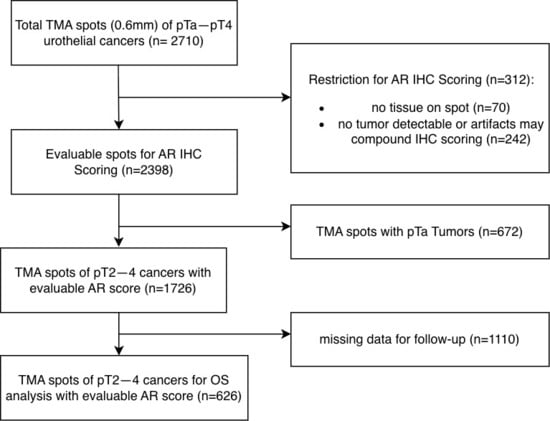
Figure 1
Open AccessSystematic Review
Intestinal-Type Adenocarcinoma Is a Rare Histotype of Vulvar Neoplasm: Systematic Review of the Literature
by
Alessio Colalillo, Dominga Boccia, Luigi Della Corte, Daniele Neola, Federica Rosato, Silvia D’Ippolito, Maria De Ninno, Damiano Arciuolo, Maurizio Guida, Giuseppe Bifulco and Francesco Cosentino
Cancers 2025, 17(24), 3989; https://doi.org/10.3390/cancers17243989 - 14 Dec 2025
Abstract
Background: Intestinal-type vulvar adenocarcinoma (VAIt) is an exceptionally rare form of primary vulvar cancer, characterized by histological features resembling mucinous colonic carcinomas, including villo-glandular structures composed of goblet and Paneth cells with intracytoplasmic mucin. Objective: To provide a comprehensive synthesis of the existing
[...] Read more.
Background: Intestinal-type vulvar adenocarcinoma (VAIt) is an exceptionally rare form of primary vulvar cancer, characterized by histological features resembling mucinous colonic carcinomas, including villo-glandular structures composed of goblet and Paneth cells with intracytoplasmic mucin. Objective: To provide a comprehensive synthesis of the existing literature on VAIt and to also report a case from our institution in order to define its clinical, pathological, and immunohistochemical characteristics and its management and prognosis. Materials and Methods: A systematic review of the literature according to PRISMA guidelines was performed through searching five electronic databases (MEDLINE, EMBASE, Web of Science, SCOPUS and Cochrane Library), considering studies from 1998 to May 2025. In our research, we included all peer-reviewed studies which reported cases of VAIt. Data about VAIt were extracted by included studies and compared. Results: All in all, 32 studies with a total of 40 cases (including our case) of VAIt were assessed. The median age at diagnosis was 58 years. Most tumors arose in the labia or perineal structures, often mimicking benign lesions. Immunohistochemistry consistently showed CK20 and CDX2 positivity, with variable CK7 and p16 expression. FIGO stage IA was the most frequent stage at diagnosis. Surgical excision was the mainstay of treatment, while adjuvant therapy was less commonly reported. Lymph node metastases were present in about 31.5% of cases. Despite aggressive histology, most patients were disease-free at follow-up. Mortality due to disease occurred in 10% of cases. Conclusions: VAIt is a very rare histotype of vulvar cancer. Compared to vulvar squamous cell carcinomas, approximately 40% of early-stage clinical diseases reported in the literature presented positive inguinal lymph nodes with recurrence even after many years. The optimal treatment is not well defined and should be based on the individual clinical history of the patient, as there are no established guidelines. Further studies and longer follow-up periods are needed to clarify the best therapeutic management and its long-term prognosis.
Full article
(This article belongs to the Special Issue Gynecological Cancers: From Bench to Bedside)
►▼
Show Figures

Figure 1
Open AccessReview
Refining Surgical Standards: The Role of Robotic-Assisted Segmentectomy in Early-Stage Non-Small-Cell Lung Cancer
by
Masaya Nishino, Hideki Ujiie, Masaoki Ito, Hana Oiki, Shota Fukuda, Mai Nishina, Shuta Ohara, Akira Hamada, Masato Chiba, Toshiki Takemoto and Yasuhiro Tsutani
Cancers 2025, 17(24), 3988; https://doi.org/10.3390/cancers17243988 - 14 Dec 2025
Abstract
Background: Recent trials, including JCOG0802/WJOG4607L and CALGB140503, have confirmed the oncological adequacy of segmentectomy for early-stage non-small-cell lung cancer (NSCLC). This shift emphasizes the preservation of pulmonary function and minimal invasiveness. Robot-assisted thoracic surgery (RATS) offers enhanced anatomical precision and potentially improves
[...] Read more.
Background: Recent trials, including JCOG0802/WJOG4607L and CALGB140503, have confirmed the oncological adequacy of segmentectomy for early-stage non-small-cell lung cancer (NSCLC). This shift emphasizes the preservation of pulmonary function and minimal invasiveness. Robot-assisted thoracic surgery (RATS) offers enhanced anatomical precision and potentially improves segmentectomy outcomes. Methods: We reviewed the current evidence comparing sublobar resection and lobectomy for early-stage NSCLC, focusing on RATS segmentectomy. Clinical trials, perioperative and long-term outcomes, technical innovations, and patient selection criteria were analyzed. Comparative data among RATS, video-assisted thoracoscopic surgery (VATS), and open approaches were synthesized, including the emerging roles of AI and 3D imaging. Results: Segmentectomy yields survival outcomes equivalent or superior to lobectomy for stage IA peripheral NSCLC ≤2 cm, with better pulmonary function despite higher locoregional recurrence. RATS enhances visualization, dexterity, and ergonomics, thereby enabling precise dissection and lymph node assessment. Compared to VATS and open surgery, RATS shows lower conversion rates, reduced pain, and comparable oncological control. Innovations, such as indocyanine green imaging, 3D modeling, and AI-guided navigation, support margin accuracy and personalized care. Conclusions: Segmentectomy has redefined the surgical standards for early-stage NSCLC. RATS maximizes the minimally invasive benefits by combining oncological safety and functional preservation. Its technical precision facilitates complex resections and integration with digital planning tools to advance personalized thoracic surgery. RATS represents the next evolution of minimally invasive thoracic surgery, redefining the balance between oncological safety and functional preservation in early-stage NSCLC.
Full article
(This article belongs to the Section Cancer Therapy)
Open AccessReview
Modulation of the Tumour Microenvironment by HER2 in Oesophagogastric Adenocarcinoma: Implications for Tumour Progression, Therapeutic Resistance, and Clinicopathological Outcomes
by
Nicola B. Raftery, Mark Ward, Narayanasamy Ravi, John V. Reynolds, Jessie A. Elliott and Claire L. Donohoe
Cancers 2025, 17(24), 3987; https://doi.org/10.3390/cancers17243987 - 14 Dec 2025
Abstract
HER2 (human epidermal growth factor receptor 2) is a receptor tyrosine kinase which is overexpressed in ~20% of patients with oesophagogastric adenocarcinoma (EGA). HER2 represents a targetable transmembrane glycoprotein receptor of the epidermal growth factor receptor (EGFR) family, which plays a crucial role
[...] Read more.
HER2 (human epidermal growth factor receptor 2) is a receptor tyrosine kinase which is overexpressed in ~20% of patients with oesophagogastric adenocarcinoma (EGA). HER2 represents a targetable transmembrane glycoprotein receptor of the epidermal growth factor receptor (EGFR) family, which plays a crucial role in cell proliferation, survival, and differentiation. HER2 significantly influences the tumour microenvironment (TME) through various mechanisms, creating a niche that supports tumour progression, immune evasion, and therapeutic resistance. In HER2-positive EGA, aberrant signalling pathways, such as PI3K/AKT and MAPK/ERK, enhance tumour cell survival and proliferation, whilst upregulation of angiogenic factors like VEGF fosters vascularization, meeting a tumour’s metabolic demands and facilitating its proliferation. HER2 also modulates the tumour immune microenvironment (TIME) by downregulating MHC molecules and recruiting immunosuppressive cells, including regulatory T-cells (T-reg) and tumour-associated macrophages (TAMs), which release cytokines that further inhibit anti-tumour immune responses. Together, these factors foster a pro-inflammatory, immunosuppressive microenvironment that underpins resistance to HER2-targeted therapies. As more HER2-directed treatments become available, such as trastuzumab–deruxtecan (T-DXd), gaining a deeper understanding of the multifaceted influence of HER2 on the TME in EGA will be crucial for the development of improved targeted treatments that can overcome these challenges and lead to advancements in targeted treatment for HER2-overexpressing EGA. This review provides a comprehensive overview of the impact of HER2 on the TME in EGA and highlights the challenge it represents as well as the opportunity for novel therapeutic development and the implications for patients in terms of clinicopathological outcomes.
Full article
(This article belongs to the Section Tumor Microenvironment)
►▼
Show Figures
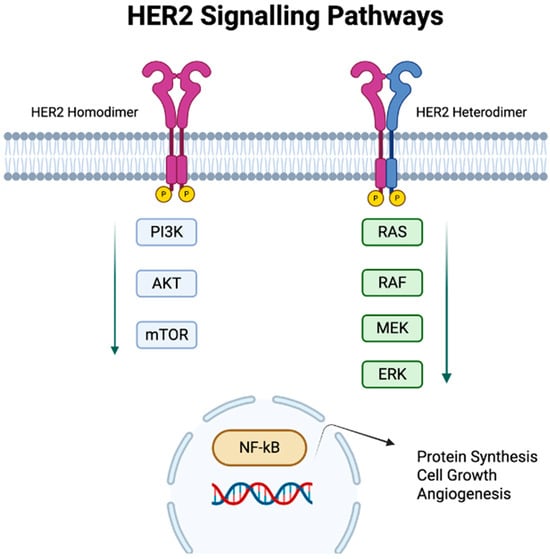
Figure 1
Open AccessArticle
Perioperative Chemotherapy in Bladder and Upper Tract Urothelial Carcinoma: Outcomes by Nodal Status and Lymphovascular Invasion
by
Nobuki Furubayashi, Jiro Tsujita, Azusa Takayama, Yuta Shiraishi, Motonobu Nakamura and Takahito Negishi
Cancers 2025, 17(24), 3986; https://doi.org/10.3390/cancers17243986 - 14 Dec 2025
Abstract
Background/Objectives: Optimal selection for perioperative therapy in urothelial carcinoma (UC) remains uncertain. We evaluated the efficacy of neoadjuvant and/or adjuvant chemotherapy (NAC/AC) for patients with bladder cancer (BC) and upper tract UC (UTUC), examined the role of lymphovascular invasion (LVI), and considered the
[...] Read more.
Background/Objectives: Optimal selection for perioperative therapy in urothelial carcinoma (UC) remains uncertain. We evaluated the efficacy of neoadjuvant and/or adjuvant chemotherapy (NAC/AC) for patients with bladder cancer (BC) and upper tract UC (UTUC), examined the role of lymphovascular invasion (LVI), and considered the implications for adjuvant nivolumab. Methods: We retrospectively analyzed consecutive patients who underwent radical cystectomy or radical nephroureterectomy at a single center (July 1998–April 2021; observation to 31 March 2025). After exclusions, 252 BC and 153 UTUC patients were included. Endpoints were cancer-specific survival, progression-free survival (PFS; BC), non-urinary-tract recurrence-free survival (NUTRFS; UTUC), and overall survival (OS). Survival was estimated by Kaplan–Meier analysis and compared by log-rank tests. Results: For BC, AC did not improve the PFS or OS in the overall pT ≥ 2 population, whereas node-positive (pN+) disease derived significant benefits in both endpoints among NAC-naïve patients (PFS and OS, p = 0.002 and p = 0.008). For UTUC, AC conferred no advantage in NUTRFS or OS for the overall pT ≥ 2 population. However, NUTRFS benefits emerged in the pN+ subset (p = 0.049), although the OS was not improved. Among NAC-treated BC, the outcomes were poorest for ≥ypT3 and ypN+, whereas ypT ≤ 2 fared better. LVI was associated with adverse outcomes and was borderline higher in pN+ versus pT ≥ 2/pN− for BC (p = 0.056) and significantly higher for UTUC (p = 0.012). Conclusions: In this retrospective, single-center cohort, our exploratory analyses suggest that perioperative benefit is largely node-dependent, supporting prioritizing systemic therapy for pN+ disease and cautioning against routine AC for pT2/ypT2 without nodal involvement. After NAC, adjuvant therapy appeared most justified for ≥ypT3/ypN+. Prospective biomarker-integrated validation is warranted and, given the small and underpowered subgroups and the potential for selection and immortal time biases, these observations should be interpreted as hypothesis-generating rather than causal.
Full article
(This article belongs to the Special Issue Immunotherapy in Urothelial Carcinoma)
►▼
Show Figures
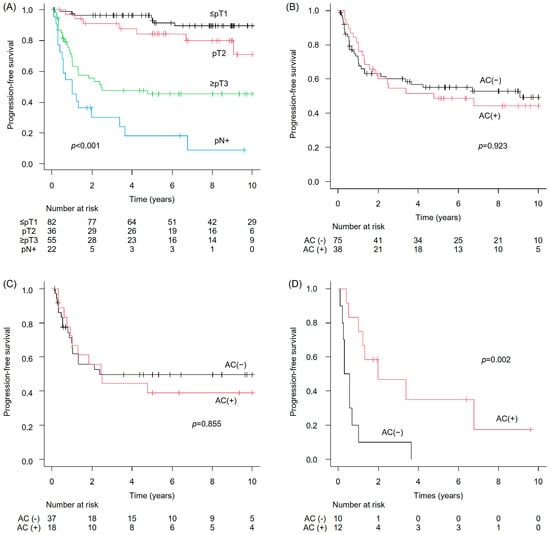
Figure 1
Open AccessReview
Artificial Intelligence and Machine Learning in Lung Cancer: Advances in Imaging, Detection, and Prognosis
by
Mohammad Farhan Arshad, Adiba Tabassum Chowdhury, Zain Sharif, Md. Sakib Bin Islam, Md. Shaheenur Islam Sumon, Amshiya Mohammedkasim, Muhammad E. H. Chowdhury and Shona Pedersen
Cancers 2025, 17(24), 3985; https://doi.org/10.3390/cancers17243985 - 14 Dec 2025
Abstract
Background/Objectives: As the primary cause of cancer-related death globally, lung cancer highlights the critical need for early identification, precise staging, and individualized treatment planning. By enabling automated diagnosis, staging, and prognostic evaluation, recent developments in artificial intelligence (AI) and machine learning (ML) have
[...] Read more.
Background/Objectives: As the primary cause of cancer-related death globally, lung cancer highlights the critical need for early identification, precise staging, and individualized treatment planning. By enabling automated diagnosis, staging, and prognostic evaluation, recent developments in artificial intelligence (AI) and machine learning (ML) have completely changed the treatment of lung cancer. The goal of this narrative review is to compile the most recent data on uses of AI and ML throughout the lung cancer care continuum. Methods: A comprehensive literature search was conducted across major scientific databases to identify peer-reviewed studies focused on AI-based imaging, detection, and prognostic modeling in lung cancer. Studies were categorized into three thematic domains: (1) detection and screening, (2) staging and diagnosis, and (3) risk prediction and prognosis. Results: Convolutional neural networks (CNNs), in particular, have shown significant sensitivity and specificity in nodule recognition, segmentation, and false-positive reduction. Radiomics-based models and other multimodal frameworks combining imaging and clinical data have great promise for forecasting treatment outcomes and survival rates. The accuracy of non-small-cell lung cancer (NSCLC) staging, lymph node evaluation, and malignancy classification were regularly improved by AI algorithms, frequently matching or exceeding radiologist performance. Conclusions: There are still issues with data heterogeneity, interpretability, repeatability, and clinical acceptability despite significant advancements. Standardized datasets, ethical AI implementation, and transparent model evaluation should be the top priorities for future initiatives. AI and ML have revolutionary potential for intelligent, personalized, and real-time lung cancer treatment by connecting computational innovation with precision oncology.
Full article
(This article belongs to the Special Issue AI-Based Applications in Cancers)
►▼
Show Figures

Figure 1
Open AccessReview
Can TP53, TMB and TME Expand the Immunotherapy Benefit in Metastatic Colorectal Cancer?
by
Monia Specchia, Denise Drittone, Eva Mazzotti and Federica Mazzuca
Cancers 2025, 17(24), 3984; https://doi.org/10.3390/cancers17243984 - 13 Dec 2025
Abstract
Background: Metastatic colorectal cancer (mCRC) with TP53 gene mutations, which are commonly found in tumors that are microsatellite stable (MSS) and not prone to genetic errors seen in some cancers, is associated with aggressive cancer behavior and poor outcomes. While MSI-high (MSI-H, referring
[...] Read more.
Background: Metastatic colorectal cancer (mCRC) with TP53 gene mutations, which are commonly found in tumors that are microsatellite stable (MSS) and not prone to genetic errors seen in some cancers, is associated with aggressive cancer behavior and poor outcomes. While MSI-high (MSI-H, referring to high levels of gene instability) disease benefits markedly from PD-1-based immunotherapy (drugs that inhibit the PD-1 protein on immune cells), TP53-mutated MSS tumors rarely receive immune checkpoint inhibitors (ICIs, drugs that help immune cells attack cancer) outside of trials and often only in later lines of therapy. Objective: We aimed to synthesize translational and clinical evidence regarding the effects of early rationale-driven immunotherapy combinations on survival outcomes, in TP53-mutated metastatic colorectal cancer, with a focus on practical clinical implications. Methods: This narrative review was conducted in accordance with SANRA criteria. Literature searches were performed in PubMed/MEDLINE, Scopus, and Web of Science (2010–2025). Relevant ESMO and NCCN guidelines and key references were also reviewed. Results: In KEYNOTE-177 study (MSI-H/dMMR), pembrolizumab improved PFS (HR 0.60) and showed durable OS with >5-year follow-up. CheckMate-142 reported sustained activity with nivolumab ± ipilimumab. Preclinical/early clinical data in MSS/TP53 suggest that ICIs may become effective when combined with priming (chemo/DDR) and vascular normalization (anti-VEGF), particularly in subsets with elevated TMB. The randomized ROME trial supports the clinical utility of genomically matched, NGS-guided strategies. Conclusions: A precision approach integrating TP53 status, TMB, and TME modulation could extend the immunotherapy benefit beyond MSI-H to TP53-mutated MSS mCRC; prospective first-line trials are warranted.
Full article
(This article belongs to the Section Cancer Metastasis)
►▼
Show Figures

Figure 1
Open AccessArticle
Epithelioid Mesothelioma Cells Exhibit Increased Ferroptosis Sensitivity Compared to Non-Epithelioid Mesothelioma Cells
by
Tatsuhiro Sato, Ikue Hasegawa, Haruna Ikeda, Taichi Ohshiro, Lisa Kondo-Ida, Satomi Mukai, Satoshi Ohte, Tohru Maeda and Yoshitaka Sekido
Cancers 2025, 17(24), 3983; https://doi.org/10.3390/cancers17243983 - 13 Dec 2025
Abstract
Background/Objectives: Mesothelioma is a highly aggressive tumor with a poor prognosis that typically develops after a long latency period following asbestos exposure. Although immunotherapy combined with chemotherapy is increasingly used, the efficacy of standard treatments remains limited. This study aimed to explore
[...] Read more.
Background/Objectives: Mesothelioma is a highly aggressive tumor with a poor prognosis that typically develops after a long latency period following asbestos exposure. Although immunotherapy combined with chemotherapy is increasingly used, the efficacy of standard treatments remains limited. This study aimed to explore ferroptosis induction as a potential therapeutic strategy for mesothelioma. Methods: We first screened microbial culture extracts collected from soil and marine environments to identify compounds with selective cytotoxicity against mesothelioma cells. Gene expression profiling was performed to investigate the mechanism of cell death induced by the identified compound. To assess intrinsic ferroptosis susceptibility, patient-derived mesothelioma cell lines and immortalized mesothelial cell lines were treated with RSL3, a GPX4 inhibitor. Results: Screening identified brefeldin A as a compound that selectively induces cell death in mesothelioma cells. Gene expression profiling revealed transcriptional changes consistent with ferroptosis induction. Treatment with RSL3 demonstrated marked variability in ferroptosis sensitivity across cell lines; the subgroup showing high sensitivity to RSL3 did not exhibit significant genetic alterations in NF2 or BAP1, but contained a significantly higher proportion of epithelioid tumors in histological classification. Conclusions: Our findings highlight ferroptosis induction as a promising antitumor mechanism in mesothelioma, particularly in the epithelioid subtype. While GPX4 inhibitors such as RSL3 are effective in vitro, further studies are needed to overcome pharmacological limitations and define molecular determinants of ferroptosis susceptibility, which may inform future personalized therapeutic strategies.
Full article
(This article belongs to the Special Issue Advances in Pleural and Peritoneal Mesothelioma)
Open AccessReview
Gaps in Diagnosis, Treatment, and Outcomes Among Patients with Brain Tumors in the United States: A State-of-the-Art Review
by
Vivek Podder, Zouina Sarfraz, Khalid Ahmad Qidwai, Arun Maharaj, Tulika Ranjan, Sonikpreet Aulakh and Manmeet S. Ahluwalia
Cancers 2025, 17(24), 3982; https://doi.org/10.3390/cancers17243982 - 13 Dec 2025
Abstract
Brain tumors, both malignant and non-malignant, represent a persistent global health challenge. Differences in diagnosis, treatment, and outcomes are influenced by race, ethnicity, socioeconomic status (SES), and geographical location. Brain and central nervous system (CNS) tumors rank 19th in global cancer incidence and
[...] Read more.
Brain tumors, both malignant and non-malignant, represent a persistent global health challenge. Differences in diagnosis, treatment, and outcomes are influenced by race, ethnicity, socioeconomic status (SES), and geographical location. Brain and central nervous system (CNS) tumors rank 19th in global cancer incidence and 12th in cancer-related mortality. U.S. Incidence is higher in females and individuals with greater socioeconomic means, contrasting with global patterns where males are more affected. Glioblastoma has a wide variation in incidence and survival by state, with rural regions showing higher mortality despite lower incidence, often due to reduced access to specialized care. Non-Hispanic Black children with CNS tumors experience higher mortality than their White peers, even after adjusting for SES. Outcomes are generally poorer in low- and middle-income countries, where healthcare infrastructure remains limited. Biological and genetic differences may also influence treatment response and tumor behavior across population groups. This review outlines key variations in brain tumor care, with a key focus on the United States, and emphasizes the need for patient-centered strategies to ensure timely diagnosis, consistent treatment, and improved outcomes.
Full article
(This article belongs to the Section Cancer Causes, Screening and Diagnosis)
Open AccessReview
Lynch Syndrome in Focus: A Multidisciplinary Review of Cancer Risk, Clinical Management, and Special Populations
by
Seyma Eroglu, Ilhan Birsenogul, Alexandra P. Bowen, Joseph F. Doyle, Stephen E. Pupkin, Joaquin Villar, Christopher M. Tarney, Edwin Gandia, Danielle M. Pastor and Juvianee I. Estrada-Veras
Cancers 2025, 17(24), 3981; https://doi.org/10.3390/cancers17243981 - 13 Dec 2025
Abstract
Lynch syndrome (LS), also known as hereditary nonpolyposis colorectal cancer (HNPCC), is a hereditary cancer syndrome significantly increasing the risk of colorectal cancer (CRC) and various extracolonic cancers, including endometrial, ovarian, and gastric cancers. LS results from germline pathogenic variants (GPVs) in DNA
[...] Read more.
Lynch syndrome (LS), also known as hereditary nonpolyposis colorectal cancer (HNPCC), is a hereditary cancer syndrome significantly increasing the risk of colorectal cancer (CRC) and various extracolonic cancers, including endometrial, ovarian, and gastric cancers. LS results from germline pathogenic variants (GPVs) in DNA mismatch repair (MMR) genes, such as MLH1, MSH2, MSH6, and PMS2, leading to microsatellite instability (MSI). This review explores the multifaceted aspects of LS, covering clinical presentation, genetic underpinnings, and emerging therapeutic strategies. The discussion explores the importance of identifying at-risk individuals, facilitating personalized cancer surveillance and prevention strategies. Molecular insights into distinguishing between sporadic and LS-associated cancers are also examined, with a focus on somatic testing methods, including MSI and immunohistochemistry (IHC). The gynecological cancer risks, particularly those related to endometrial and ovarian malignancies, are addressed, underscoring the need for early detection and risk-reducing interventions. Recent advancements in the management of colorectal and other LS-related cancers are highlighted, with particular attention to the growing role of immunotherapy, including immune checkpoint inhibitors, and immunoprevention strategies. With ongoing advances in our understanding of LS, opportunities for earlier detection, more effective prevention, and innovative treatments continue to expand. This narrative review adopts a multidisciplinary approach to provide a comprehensive understanding of LS, from its genetic basis to current clinical and therapeutic practices, with the ultimate goal of improving patient outcomes and enhancing the quality of care.
Full article
(This article belongs to the Special Issue Lynch Syndrome (HNPCC): Symptoms, Causes, and Outlooks)
Open AccessArticle
A Real-World Experience on the Efficacy of First-Line Treatment with Immune-Checkpoint Inhibitors in Non-Small-Cell Lung Cancer Patients with PD-L1 Expression ≥50%: The Role of KRAS Mutations
by
Lucia Motta, Samantha Epistolio, Jana Pankovics, Francesca Molinari, Benjamin Pedrazzini, Alexandra Valera, Luca Giudici, Stefania Freguia, Miriam Patella, Martina Imbimbo, Giovanna Schiavone, Milo Frattini and Patrizia Froesch
Cancers 2025, 17(24), 3980; https://doi.org/10.3390/cancers17243980 - 13 Dec 2025
Abstract
►▼
Show Figures
Background/Objectives: Several genetic alterations have been identified as drivers of uncontrolled cell growth in lung cancer, with KRAS mutations representing the most prevalent driver oncogene. Despite advances in targeted treatment, the 5-year survival rate of patients with advanced/metastatic NSCLC is still less than
[...] Read more.
Background/Objectives: Several genetic alterations have been identified as drivers of uncontrolled cell growth in lung cancer, with KRAS mutations representing the most prevalent driver oncogene. Despite advances in targeted treatment, the 5-year survival rate of patients with advanced/metastatic NSCLC is still less than 20%. This study aims to assess the clinical relevance of KRAS mutations in the context of PD-L1 expression, focusing on patients with PD-L1 Tumor Proportion Score (TPS) ≥ 50% and treated with first-line immune checkpoint inhibitors (ICIs). Methods: We conducted a retrospective analysis of a real-world cohort comprising all staged NSCLC patients diagnosed and treated between 2018 and 2022 at our Institution with the available Next Generation Sequencing and PD-L1 immunohistochemistry results. Statistical analyses were made using the log-rank test, the two-tailed Fisher’s exact test, and Kaplan–Meier survival curves. Results: Among 520 NSCLC patients, 288 were adenocarcinoma (AC). Of these, 110/288 (38.2%) were KRAS mutants, and 83/278 (29.8%) presented a PD-L1 TPS ≥ 50%. In this subgroup, KRAS mutants demonstrated longer median overall survival (mOS) and progression-free survival (PFS) compared to the KRAS wild-type (28.7 vs. 10.7 months, p = 0.010; 6.4 vs. 3.5 months, p = 0.005, respectively). While OS did not differ among KRAS mutation subtypes, PFS was significantly shorter in patients with p.G12D (3.5 months, p = 0.03). Conclusion: This study is the first to investigate the interplay between KRAS mutations and PD-L1 expression in a real-world stage IV lung AC cohort treated with ICIs. Our findings indicate that the p.G12D mutation is associated with an extremely severe disease upon ICI monotherapy. These preliminary results need further validation in larger, prospective cohorts.
Full article
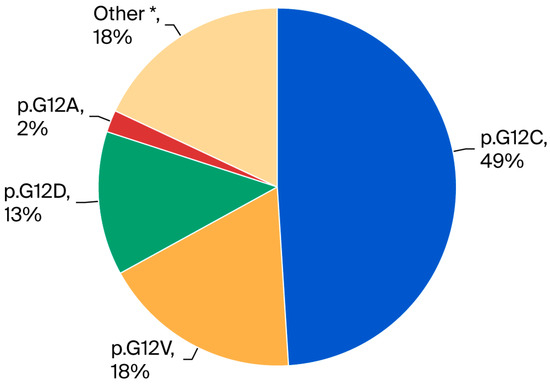
Figure 1

Journal Menu
► ▼ Journal Menu-
- Cancers Home
- Aims & Scope
- Editorial Board
- Reviewer Board
- Topical Advisory Panel
- Instructions for Authors
- Special Issues
- Topics
- Sections & Collections
- Article Processing Charge
- Indexing & Archiving
- Editor’s Choice Articles
- Most Cited & Viewed
- Journal Statistics
- Journal History
- Journal Awards
- Society Collaborations
- Conferences
- Editorial Office
Journal Browser
► ▼ Journal BrowserHighly Accessed Articles
Latest Books
E-Mail Alert
News
Topics
Topic in
Cancers, IJERPH, IJGI, MAKE, Smart Cities
The Use of Big Data in Public Health Research and Practice
Topic Editors: Quynh C. Nguyen, Thu T. NguyenDeadline: 31 December 2025
Topic in
Biomolecules, Cancers, Cells, JMP, Livers
Signaling Pathways in Liver Disease 2nd Edition
Topic Editors: Ralf Weiskirchen, Amedeo AmedeiDeadline: 20 March 2026
Topic in
Cancers, IJMS, Pharmaceuticals, Pharmaceutics, Sci. Pharm., Current Oncology, Molecules
Recent Advances in Anticancer Strategies, 2nd Edition
Topic Editors: Hassan Bousbaa, Zhiwei HuDeadline: 31 March 2026
Topic in
Biomedicines, Cancers, JCM, Nanomaterials, Pharmaceutics, JNT
Application of Nanomaterials and Nanobiotechnology in Cancer
Topic Editors: Ayan Kumar Barui, Susheel Kumar NethiDeadline: 31 May 2026

Conferences
Special Issues
Special Issue in
Cancers
The Impact of Minimally Invasive Surgery on Gynecologic Cancers
Guest Editor: Gabriel LevinDeadline: 20 December 2025
Special Issue in
Cancers
IBD-Associated Cancer
Guest Editor: Takayuki OginoDeadline: 20 December 2025
Special Issue in
Cancers
Histopathology and Pathogenesis of Skin Cancer
Guest Editors: Carlos Torres-Cabala, Alessio GiubellinoDeadline: 20 December 2025
Special Issue in
Cancers
Translational Cancer Research in Multiple Myeloma, with a Focus on Immune Therapies and Novel Agents – “The Bench Behind the Bedside”
Guest Editors: Paul Richardson, Constantine Mitsiades, Shonali MidhaDeadline: 20 December 2025
Topical Collections
Topical Collection in
Cancers
Particle Therapy: State-of-the-Art and Future Prospects
Collection Editors: Chia-Ho Hua, Matthew J. Krasin
Topical Collection in
Cancers
Artificial Intelligence in Oncology
Collection Editors: Andreas Stadlbauer, Anke Meyer-Baese, Max Zimmermann
Topical Collection in
Cancers
The Molecular Predictive and Prognostic Biomarkers in Breast Cancer
Collection Editors: Daniele Generali, Ida Paris



